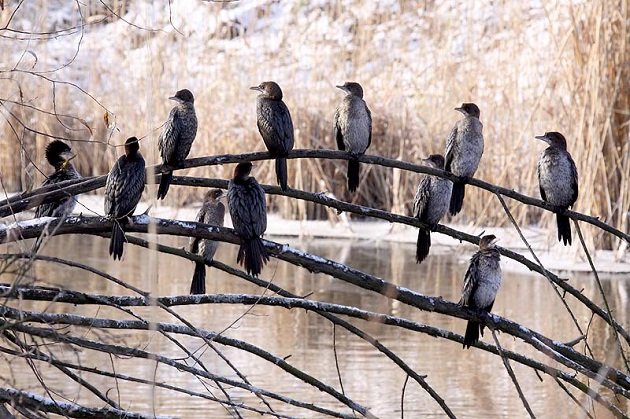
It all started during the icy February of 1996. The night temperatures in Belgrade, Serbia, were already below minus 10 Celsius / 14 degrees Fahrenheit for two weeks. Everything was frozen solid and pack ice floating down the Danube. Hiding from the elements at the riverbank, I was sitting in a Yugo and staring at the murky sky. Whenever the windscreen got frozen, I could not afford to turn the engine on due to petrol shortages (during the UN embargo on the import of fuel to the former Yugoslavia), so I would turn on a mini camping gas stove to defrost the windows and warm up my cocoon, keeping one eye at the sky and the other at the flames, to make sure they do not catch the seat (I am sure all of you have tried, and some of you mastered, that chameleon birding technique – one eye on the road, the other on the birds).
What was I doing there? Back in those days, Pygmy Cormorants Microcarbo pygmeus were considered Vulnerable by the IUCN Red List and were quite uncommon, having just returned to the city after half a century of absence. In that February, my ignorance has finally boiled to crystalise into a question: Why is it that I see only dozens and not the low hundreds of PCs known to overwinter in Belgrade? And asking yourself the right question is more than half the way towards the answer.
Looking for that answer, I found myself sitting in a half-frozen Yugo and staring at the sky, counting numerous black dots mowing from their feeding shallows to their roosting site. Their known numbers at the time were 500 and I was quite surprised to count twice as many – I was a young birder who has just discovered something unnoticed and unknown! And that is how my hanging out with (some call it monitoring of) the cormorants started, almost 20 years ago.
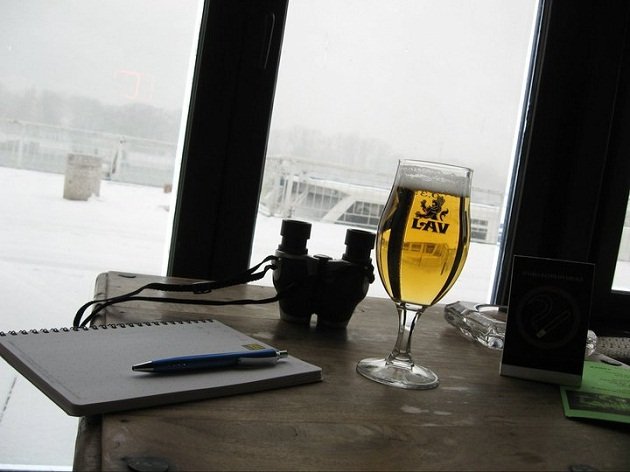 Large windows and unobstructed views of the river are a criterion for the right observation point.
Large windows and unobstructed views of the river are a criterion for the right observation point.
Back to the present time, I am sitting in a cafe spreading a watch, notebook, pen and binoculars over the table and ordering a pint of beer. While choosing a Pygmy Cormorant Watch cafe, the main criterion is that it must have large windows and unobstructed views of the river. And, yes, a cold lager and a good heating – I am getting older. Or wiser, perhaps?
Up to the mid-20th century, Pygmy Cormorants were a common breeding species of wetlands around Belgrade… until the wetlands were drained and the birds were lost, at one moment – from the whole of Serbia. With the construction of the huge Iron Gates dam on the Danube, the birds returned to breed in newly flooded river islands, and in late 1980s returned to Belgrade, too, but only to overwinter within the city.
In the last few hours of daylight, Pygmy Cormorants are commuting back to their roost in the Sava River. During their lunch break, they spread up and down the Danube and, in smaller numbers, up the Sava, and after lunch, they all come back to several willow groves by the Ada Ciganlija Island, using the rivers as the flight corridors. Therefore, you can count them all if you spread enough experienced counters to spend the last hours of the day observing all the corridors and distinguishing distant black PC dots from other equally distant and black Rook and Eurasian Jackdaw dots, all of them melting into treecrowns in winter sunsets.
By both Serbian legislation and the Bern Convention on the Conservation of European Wildlife and Natural Habitats, Pygmy Cormorant is a strictly protected species. In the European Union, PCs are at the Annex I of the Birds Directive and their habitats are therefore a potential NATURA2000 ecological network sites.
I haven’t even finished spreading gear over the table when the first commuters appear. Ones, twos, fives… the birds are flying up the Sava River, then one more serious flock of 90 birds, then those twos and fours again. Sunset takes over, guests are slowly filling up the cafe and the lights are on… which I hate because now I have to count the PCs between the light reflections in the windows.
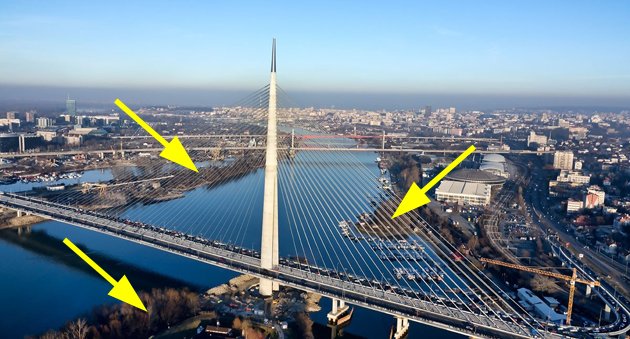 In order to get to their roosts, Pygmy Cormorants have to negotiate various obstacles.
In order to get to their roosts, Pygmy Cormorants have to negotiate various obstacles.
The biggest threat to Pygmy Cormorants overwintering in Belgrade is urbanisation of its riverbanks and destruction of remaining willow groves. In 2008, one such grove was buried under the 200 metres tall pylon of the new bridge, which sparkled the initiative by the Belgrade Land Development Public Agency, League for Ornithological Action of Serbia (a local NGO) and the Institute for Nature Conservation of Serbia to protect the remaining roosting sites of this species.
As the Sun gets lower, the flocks are getting more numerous and bigger in size, going commonly up to 15, 30, 45 and more individuals. I am counting them frenetically, scared that I might miss a flock while writing the previous one down.
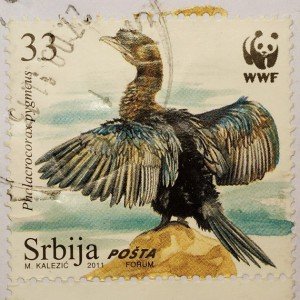 The monitoring done in the last nine years by the working group from the League for Ornithological Action of Serbia has shown that Pygmy Cormorants reach their peak numbers in November and early December. One such December was in 2007, when PCs reached a record 6750 individuals, or 10 per cent of their European population and 4% of their global population.
The monitoring done in the last nine years by the working group from the League for Ornithological Action of Serbia has shown that Pygmy Cormorants reach their peak numbers in November and early December. One such December was in 2007, when PCs reached a record 6750 individuals, or 10 per cent of their European population and 4% of their global population.
According to the European Union Birds Directive, one of the main criteria for creation of the Special Protected Areas is the 1% population threshold and therefore, without any doubt, this area is of great international importance for the birds themselves, as well as for the country that aims towards the EU membership.
The Sun has already set, but for the Pygmy Cormorants, it is a mere signal that it is time for the traffic jam: 100, 150, 200, 100, 500… By now, the flocks are flying one after another, creating one huge continuous mass but, as the sunset thickens, PCs are flying lower, at the height of the treecrowns of the other bank, melting into Rook filled tree branches in the background. Only after the darkness overtakes the twilight, the flocks are finally gone.
In December of 2011, we had 6500 Pygmy Cormorants, but the February next year was very harsh. The Danube got solid frozen from bank to bank, making it impossible for diving birds to find food. Their mortality was huge, but I realised how huge only when we did the December 2012 census to find only 1300 PCs. Four fifths were gone! Yet, they are nothing if not resilient. In December 2013, we already had 2200 birds.
Now I am curious: How many did we counted today?? I cannot wait to get home to sum my counts and to rush the others to hurry with theirs, to discover that we had counted 5000 birds, or 7% of their European population and 3% of their global population!
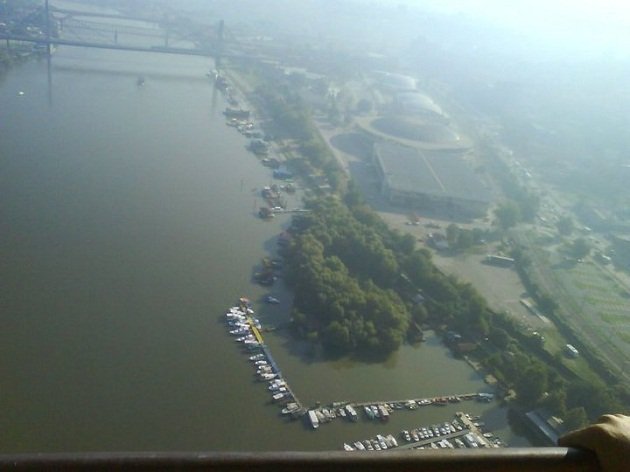 During the construction of the new bridge inside the roosting sites, I had the opportunity to be hauled up the pylon in a basket, to see the willow groves as the birds see them. This one’s very existence is being disputed by the proposed reserve management authority.
During the construction of the new bridge inside the roosting sites, I had the opportunity to be hauled up the pylon in a basket, to see the willow groves as the birds see them. This one’s very existence is being disputed by the proposed reserve management authority.
Since the roosts of Pygmy Cormorants should receive official protection, how bright is the future? As the roosting groves lie along the Sava riverbanks within Belgrade, the Beogradvode – Belgrade Water Board was proposed to manage the future nature reserve. And that is where the problem arose: it is their job to clear all the sediments collecting against the embankment. The main willow grove, the one by the Belgrade Fair (the right bank), has overgrown a mud bank, which they haven’t cleared for more than two decades. Now, when the vegetation has fixed the sediments and the birds discovered a perfect roosting site, the Belgrade Water Board want to perform their long delayed duties (and Pygmy Cormorants are protected against any such disturbance by Serbian legislation, too). Because of that opposition, the protection proposal has not yet been discussed nor voted for in the Assembly of the City of Belgrade. And the biggest urban Pygmy Cormorant roost in the World is hanging in limbo.
For the birds protection sake, as well as the future of my country within the EU, I sure do hope that the Ambassador Michael Davenport, Head of the European Union Delegation to the Republic of Serbia, follows my blog.
Cover photo (c) by Maciej Szymanski.
Edit: After this blog was published, Vladimir Mladenov from Bulgaria informed me about a larger roost at the Burgas Lakes, so I had to edit the text slightly to reflect that fact.













Thanks for an interesting post! I’d never even heard of Pygmy Cormorants. It’s nice you can observe them from a convenient café!
Great post, Dragan! I only had Pygmy Cormorant once, during my visit to Hungary a couple of years ago, and would love to see that many at once!
Is there anything that birders can do to help keep this important roost protected?
Nothing I can think of, just stay alert.